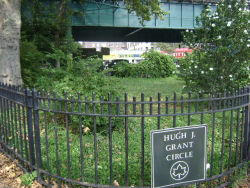Hugh J. Grant Circle
The Daily Plant : Tuesday, March 9, 2004
NAMING NAMES
It is fairly easy to determine the origins of some park names: Brooklyn Bridge Park is adjacent to the Brooklyn Bridge; Central Park is in the middle of Manhattan. Other park names are a bit more mystifying. What is Smokey Oval Park named after? Did a street car once run through Trolley Car Triangle? And who’s the namesake for Hugh Grant Circle?
Every park name has a story behind it, and with the unbeatable help of Parks Librarian John Mattera (a wellspring of fascinating, obscure information), this Plant offers an explanation for why the three aforementioned parks bear the names they do. “It is important to keep in mind that for the most part, park naming has been a matter of chance. People in positions of power felt someone's life merited the honor of a park naming, and at the same time, there had to be a park on hand,” remarked John.
From the time it opened in 1938, Queens’ Smokey Oval Park has borne the same name, and in 1987, Parks made it official. Smokey Oval is so named because it stands across from a Long Island Railroad terminus, where billowing train smoke once deposited layers of soot and ash onto the neighboring land. The name is also inspired by the oval-shaped mound at the entrance to the park.
Today, the community uses the park for many purposes. In 1998, a Park Awareness Day was held in Smokey Oval Park; Agenda 21, a neighborhood political organization, has held several community days at Smokey Oval; the Federation of Indian Associations holds its annual “Phagwah Parade” celebration there; and the Indo-Caribbean Federation holds an annual concert at Smokey Oval.
The origins of the Trolley Car Triangle name date back even farther to 1894, when the first Brooklyn City trolley car entered Queens County. In the summer of that year, the Grand Street line was opened, running between the Maspeth Depot and Broadway, and was soon extended to Junction Avenue and across to Bowery Bay. The Grand Street cars ran through the neighborhood of Jackson Heights, which has preserved a rich history of the trolley lines. One can still find spots of exposed trolley tracks and original bricks where the pavement has worn away, affording a glimpse of 1890s Queens.
Hugh Grant Circle might conjure up images of a dashing English actor, but the park was actually named after former New York City Mayor Hugh J. Grant (1857-1910) on December 5, 1911 by the Board of Aldermen. Bounded by 177th Street and Virginia and Westchester Avenues, Hugh J. Grant Circle is located in the eastern Bronx neighborhood of Parkchester. Grant was a native New Yorker, educated in Catholic schools in the United States and Berlin before attending Columbia University Law School. His father, the owner of several West Side taverns, helped Grant make connections with the many local Irish-American organizations that aided his political career. Backed by Tammany Hall, Grant became a New York Alderman in 1882, sheriff of New York in 1885, and finally mayor in 1889. Inaugurated at only 31 years of age, Grant is remembered as New York City's youngest mayor.
Ironically, Grant is also known for his opposition to state intervention in city affairs, an issue that led him to oppose the acquisition of Pelham Bay and Van Cortlandt Parks. He believed the parks were too expensive to acquire and develop and too inaccessible for most New York City residents. Grant may be the only person in New York City history who fought against parks and nonetheless has a park named after him.
QUOTATION FOR THE DAY
“Gradually from naming an object we advance step by step until we have traversed the vast distance between our first stammered syllable and the sweep of thought in a line of Shakespeare.”
Helen Keller
The Story of My Life,1905
Check out your park's Vital Signs
Clean & Safe
Green & Resilient
Empowered & Engaged Users
Share your feedback or learn more about how this park is part of a
Vital Park System





